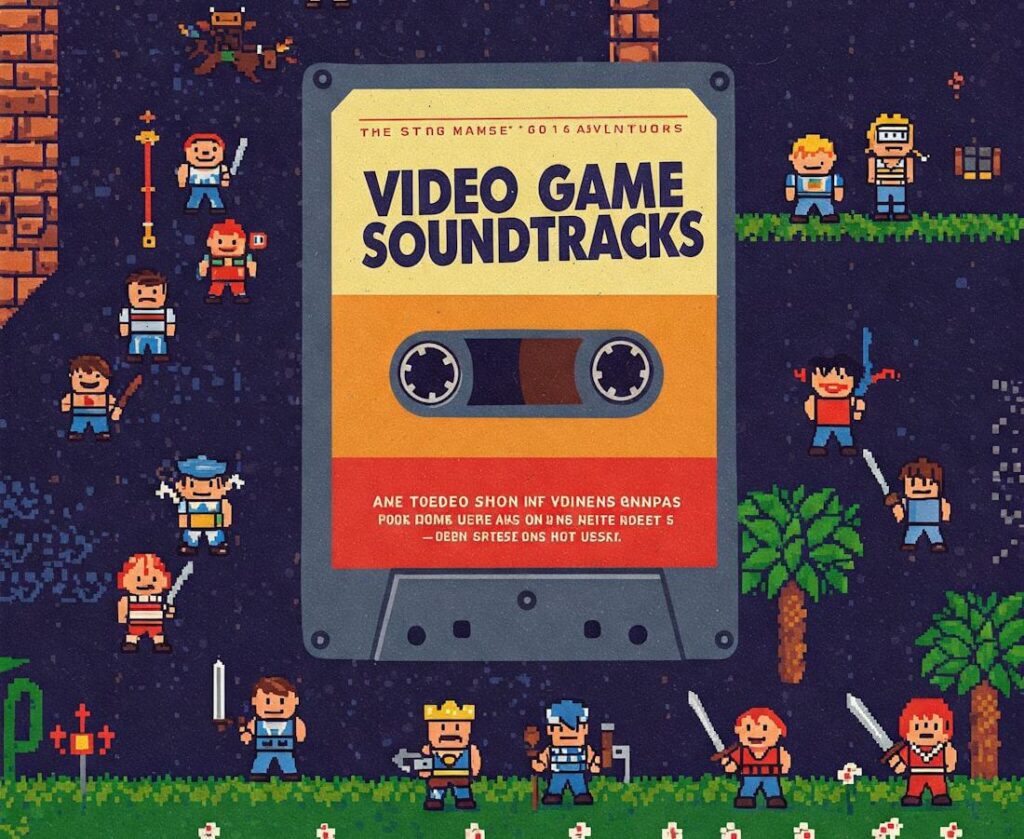The Importance of Soundtracks in Gaming
The significance of soundtracks in video games cannot be overstated; they play a crucial role in shaping the overall gaming experience. Music enhances the engagement of players by creating an immersive atmosphere that draws them into the virtual worlds they inhabit. Through carefully composed soundtracks, developers are able to evoke a wide range of emotions, from excitement and tension to nostalgia and tranquility, which enrich the narratives and gameplay mechanics.
Game soundtracks serve not only as auditory companionship but also as a vital storytelling mechanism. A well-crafted score can complement the visual elements of a game, establishing a dynamic synergy that heightens emotional responses. For instance, a suspenseful musical piece can amplify a critical moment, making players feel a heightened sense of intrigue or fear. Conversely, a serene melody can provide a sense of relief and comfort during moments of exploration, accentuating the beauty of the game world. The power of a soundtrack lies in its ability to transport the player beyond mere interaction with visual elements into a deeper, more meaningful experience.
Moreover, iconic soundtracks often become synonymous with the games themselves, leaving lasting impressions long after the gaming session has ended. Fans frequently find themselves reminiscing about their favorite scenes, vividly recalling the specific music that accompanied them. This attachment can cultivate a sense of loyalty and nostalgia that enhances the overall culture surrounding a video game franchise. As we explore the top five video game soundtracks, it is essential to acknowledge the vital role these compositions play in elevating games into artistic expressions. Ultimately, soundtracks not only enhance gameplay but also forge emotional connections that resonate with players across different generations.
The Legend of Zelda: Ocarina of Time
The soundtrack of ‘The Legend of Zelda: Ocarina of Time’ is not only iconic but also plays a pivotal role in crafting the emotional landscape of the game. Composed by Koji Kondo, the music captures the essence of adventure, nostalgia, and exploration, immersing players in the enchanting realms of Hyrule. The compositions range from upbeat melodies to haunting themes, seamlessly aligning with the various environments and challenges faced by the protagonist, Link. Each piece is meticulously designed to evoke emotion, enhancing the overall gaming experience.
Central to the soundtrack is the ocarina, a wind instrument that serves both as a gameplay mechanic and a narrative device. Players utilize the ocarina to play different melodies, which unlock significant game features, such as changing the time of day or summoning rain. This duality of purpose enriches the player’s connection to the music, transforming each note into an integral element of the story. For instance, the ‘Song of Time’ not only resonates due to its haunting beauty but also symbolizes the passage of time—a central theme in Link’s quest.
Key musical pieces such as ‘Gerudo Valley,’ with its spirited tempo, and ‘Zelda’s Lullaby,’ which evokes a deep sense of comfort and nostalgia, anchor the emotional journey throughout Ocarina of Time. The historical context of these compositions within the broader ‘Legend of Zelda’ series reveals a lineage of musical themes that echo throughout subsequent titles. This continuity showcases Kondo’s artistry and how it has shaped the identity of the series, making the soundtrack a timeless element that resonates with both longtime fans and new players alike. The profound impact of this game’s music not only elevates the gameplay experience but endures in the hearts of its audience. In conclusion, the soundtrack of ‘The Legend of Zelda: Ocarina of Time’ represents a landmark achievement in video game music, blending mechanics with emotional storytelling.
Final Fantasy VII
Final Fantasy VII, released in 1997, is often hailed as a watershed moment in video game history, not only for its innovative gameplay and narrative but also for its groundbreaking soundtrack composed by Nobuo Uematsu. The music of Final Fantasy VII features a rich diversity of orchestral arrangements, ranging from grand, sweeping themes that encapsulate the game’s epic scope to more intimate pieces that highlight character development and emotional depth.
Uematsu’s ability to create memorable themes for each character is one of the standout features of the game’s score. For instance, the emotionally charged theme associated with Aerith Gainsborough resonates deeply with players, evoking both joy and sorrow tied to her character arc. Such themes are not mere background scores; they serve as a narrative tool, enhancing players’ emotional connection to pivotal moments within the game. The ferocity of the battle themes captures the urgency of combat while contrasting elegantly with serene melodies that accompany exploration and discovery throughout the expansive world of Gaia.
The orchestration utilized in Final Fantasy VII extends beyond traditional gaming soundtracks, embracing a full orchestral sound that was unprecedented at the time of its release. This shift elevated the auditory experience, showcasing the potential of video game music to achieve a cinematic quality. Notably, orchestral renditions of the soundtrack have been performed in concert settings, emphasizing its lasting influence and popularity. The acclaim earned by Uematsu’s compositions solidified Final Fantasy VII’s status as a classic in the RPG genre, demonstrating how a meticulous approach to musical storytelling can significantly enhance the gameplay experience.
3. Journey
One of the most remarkable aspects of Journey, developed by Thatgamecompany, is its unique and immersive soundtrack, composed by Austin Wintory. This video game stands out not only for its stunning visual artistry but also for its musical composition, establishing a profound auditory experience that enhances gameplay. Wintory’s score is crafted to evolve organically in response to the player’s actions, creating a harmonious relationship between sound and gameplay dynamics.
The music in Journey serves multiple purposes, accentuating emotional moments throughout the player’s exploration of a vast desert landscape. As players embark on their journey, the music dynamically shifts, reflecting their emotional state as well as the atmosphere. For instance, when players ascend to new heights or descend into depths, the accompanying score transitions seamlessly, offering a deeply engaging experience that enhances the storytelling element of the game. This synergy between the visuals, gameplay mechanics, and audio creates a unique, reflexive experience, where each note and chord corresponds to the player’s journey.
Furthermore, Wintory’s composition incorporates a rich array of instruments and vocal elements, creating a soundscape that feels both ancient and contemporary. The integration of the player’s interactions with the music adds an additional layer of complexity; every action taken can influence the auditory landscape, allowing the soundtrack to evolve dynamically. This interaction not only immerses players further into the game world but also strengthens their emotional connection with the unfolding narrative. Journey transcends traditional video game soundtracks, exemplifying how music can significantly enhance a player’s experience in gaming.
Halo: Combat Evolved
The soundtrack of Halo: Combat Evolved, composed by Martin O’Donnell and Michael Salvatori, is widely regarded as one of the most influential scores in video game history. This composition is notable for its ability to evoke a sense of epic grandeur, integrating orchestral arrangements with choral elements that resonate with players long after they have left the game. The thematic material skillfully complements the game’s narrative and settings, enhancing the emotional experience of each encounter.
One of the most iconic themes from the soundtrack is the main theme, characterized by its haunting Gregorian chants and powerful orchestral motifs. This theme has become synonymous with the franchise, establishing a sonic identity that is both memorable and distinct. The way it underscores key moments in the game, particularly during intense battles or significant story developments, is masterful. The music effectively communicates an atmosphere of urgency and heroism, immersing players in the ongoing conflict between humanity and the alien Covenant.
Moreover, the sound design in Halo: Combat Evolved is meticulously crafted to enhance gameplay. Soft, ambient tracks accompany exploration phases, allowing players to absorb the vast alien landscapes while still preparing them for imminent conflicts. When transitioning to battle scenes, the score elevates in intensity, blending seamlessly with the action. This dynamic range ensures the music serves as a powerful narrative device, guiding emotional responses and enhancing overall engagement.
Overall, the soundtrack of Halo: Combat Evolved is a critical component of the gaming experience. Its profound impact on the franchise exemplifies how music can shape player perceptions, making it an essential element for understanding the identity of this landmark title in video game history.
5. The Elder Scrolls V: Skyrim
Considered one of the most iconic video game soundtracks of all time, the music of The Elder Scrolls V: Skyrim, composed by Jeremy Soule, plays an integral role in enhancing the gaming experience. This orchestral score, which ranges from delicate melodies to sweeping symphonic arrangements, captures the vastness and beauty of Skyrim’s open world. Each composition is designed to enrich exploration, providing a sense of immersion that the players feel deeply as they traverse the land.
The thematic richness of the soundtrack is evident in tracks such as “Dragonborn,” which features powerful choral elements that evoke a sense of heroism and destiny. This particular piece notably plays during key moments, augmenting the game’s narrative and allowing players to feel the weight of their adventures. The track masterfully encapsulates the essence of the Dragonborn, the prophesied hero of Skyrim, and serves as a focal point when engaging in battles against formidable foes.
Another noteworthy piece is “Secunda,” a serene yet haunting composition that plays during the peaceful nighttime hours in the game. The gentle melodies complement the stunning visual landscapes, capturing the ethereal beauty of the snowy mountains and vast plains. This track effectively illustrates the game’s dynamic atmosphere, as players can feel a sense of calm after a day of intense quests. Additionally, “Into Darkness” stands out during pivotal moments when players venture into eerie dungeons or face unsettling enemies. The score heightens the suspense, keeping players on the edge of their seats.
The Elder Scrolls V: Skyrim’s soundtrack not only enhances the gameplay but also leaves a lasting impression on players long after they’ve put down their controllers. It is a testament to how music can elevate a gaming experience, transforming each moment into something truly memorable.
The Evolution of Video Game Music
The journey of video game music dates back to the early days of gaming, where technology heavily influenced the soundscapes of the time. In the late 1970s and early 1980s, the introduction of 8-bit systems allowed composers to create simple melodies characterized by catchy, repetitive tunes. These compositions, often limited to a few simultaneous notes, laid the groundwork for the soundtracks that would come to define gaming culture. Games like “Pac-Man” and “Super Mario Bros.” featured iconic themes that quickly became etched in the memories of players worldwide.
As the medium evolved, so too did the complexity of its music. The advent of 16-bit systems in the early 1990s marked a significant turning point. With enhanced sound hardware, game composers began to explore richer harmonies and more intricate arrangements. Titles such as “The Legend of Zelda: A Link to the Past” and “Street Fighter II” showcased how game soundtracks could enhance narrative depth and emotional impact. This era heralded a shift where music was no longer merely an accompaniment but an integral part of the gaming experience.
The advancement of technology continued into the late 1990s and early 2000s with the introduction of CDs as a format for storing soundtracks. Games could now incorporate high-fidelity audio and orchestrated scores, exemplified by titles such as “Final Fantasy VII” and “Halo.” These soundtracks featured the work of renowned composers and created immersive worlds that players could lose themselves in. This trend of high-quality production values has continued to the present day, where full orchestras are often employed to create expansive soundscapes.
Today, video game music is celebrated as a significant art form, with composers recognized for their contributions to the medium. Soundtracks can range from upbeat chiptunes to cinematic orchestral pieces, showcasing the diverse evolution that has shaped video game music into an essential component of player engagement and emotional storytelling.
The Role of Music in Game Design
Music has always been a fundamental aspect of video game design, serving not only as an aural backdrop but also as a key component that shapes player experience. The strategic use of soundtracks enhances gameplay mechanics, sets the mood, and signals important transitions within narratives. Composers meticulously craft soundtracks to evoke emotions, providing cues that align with gameplay dynamics. For instance, an escalating score during critical moments heightens tension and excitement, while a softer melody can evoke feelings of tranquility, underscoring exploration or reflection.
In interviews, renowned composers often emphasize the importance of thematic consistency throughout their work. A well-composed video game soundtrack fosters a cohesive atmosphere that resonates with players, allowing them to immerse themselves fully in the game world. The repetition of certain musical motifs can help players form connections with characters or key story elements, reinforcing emotional stakes and creating memorable experiences. These motifs serve as auditory anchors that stabilize the gameplay environment, guiding players through complex narratives with an effortless feel.
Moreover, the role of music in indicating transitions is pivotal in game design. For example, when a player reaches the end of a level, a shift in musical tone not only signifies a conclusion but also prepares them for what lies ahead. Likewise, a change from serene melodies to frenetic beats can indicate an impending challenge or conflict, alerting the player to react accordingly. This careful orchestration of sound allows for a dynamic interplay between the music and game mechanics, reinforcing the overall narrative.
As the industry evolves, the integration of adaptive music—where the soundtrack responds to player actions—has further revolutionized the role of music in gaming. Such innovation enhances engagement, ensuring that players are emotionally connected to their journey. Ultimately, the significance of music in game design cannot be overstated; it is an art form that elevates video games from mere entertainment to profound experiences that resonate long after the screen fades to black.
Fan Culture and Soundtrack Appreciation
Video game soundtracks have evolved from mere auditory backdrops to pivotal elements that enhance the gaming experience, fostering a vibrant fan culture dedicated to their appreciation. As technology has progressed, the quality and complexity of video game music have significantly improved, leading to a deeper emotional connection between players and the games they love. This artistic evolution has led fans to engage with soundtracks beyond their respective games, spawning an array of creative expressions, including remixes and covers.
Online platforms such as YouTube, SoundCloud, and Bandcamp have become vital spaces for enthusiasts to share their renditions and interpretations of video game music. Fans often remix their favorite tracks, providing fresh takes that reimagine the original compositions while showcasing their musical talent. These community-driven projects not only amplify the popularity of video game soundtracks but also highlight the collaborative spirit among fans, blurring the lines between creators and audiences. The rise of platforms that cater to video game music has also enabled broader exposure for aspiring musicians who aim to contribute to this dynamic scene.
Live orchestral performances of video game soundtracks have further cemented the genre’s legitimacy within the broader musical landscape. Events like the Video Games Live concert series and symphonic performances by major orchestras have attracted diverse audiences, transcending the traditional boundaries of classical music. This merging of gaming and orchestral performance underscores the significance of video game soundtracks, allowing fans to experience their favorite music in an engaging and communal environment. The growing recognition of video game music within both the industry and academia underscores its cultural importance, proving that soundtracks are not just accessories but integral components of storytelling and emotional engagement in gaming.
Conclusion: Why You Should Listen to Video Game Soundtracks
Video game soundtracks play a pivotal role in enhancing the overall gaming experience, transcending mere background noise to become an integral part of the narrative and emotional journey of the players. These compositions are meticulously crafted to complement the gameplay, evoke particular emotions, and paint vivid auditory landscapes that resonate deeply with gamers. The melodies can linger long after the console is turned off, often becoming ingrained in personal memories linked to the gaming experience.
Listening to video game soundtracks offers more than just an appreciation for the music; it opens a gateway to nostalgia, allowing individuals to relive their gaming moments through sound. The immersive quality of these soundtracks often enhances atmosphere and tension in games, creating a lasting impression that encourages players to return to their favorite titles time and again. Renowned composers and artists have poured their creativity into these scores, producing sonic masterpieces that stand up to analysis alongside classical music or contemporary genres.
By exploring the top five video game soundtracks highlighted in this blog post, readers can appreciate how these compositions contribute significantly to the art of storytelling in games. It invites them to reflect on their personal experiences with music from various games and how it has impacted their lives, whether through enhancing emotional moments or creating a sense of adventure. Engaging with these soundtracks can foster a new appreciation for the craft behind video game audio and encourage discussions within the community about one’s favorites and cherished memories.
Ultimately, venturing into the realm of video game music is not just a recommendation; it is an invitation to discover the power of sound in elevating interactive experiences. Enjoying these soundtracks can lead to deeper connections with the art form itself and enrich players’ overall engagement with the world of gaming.



